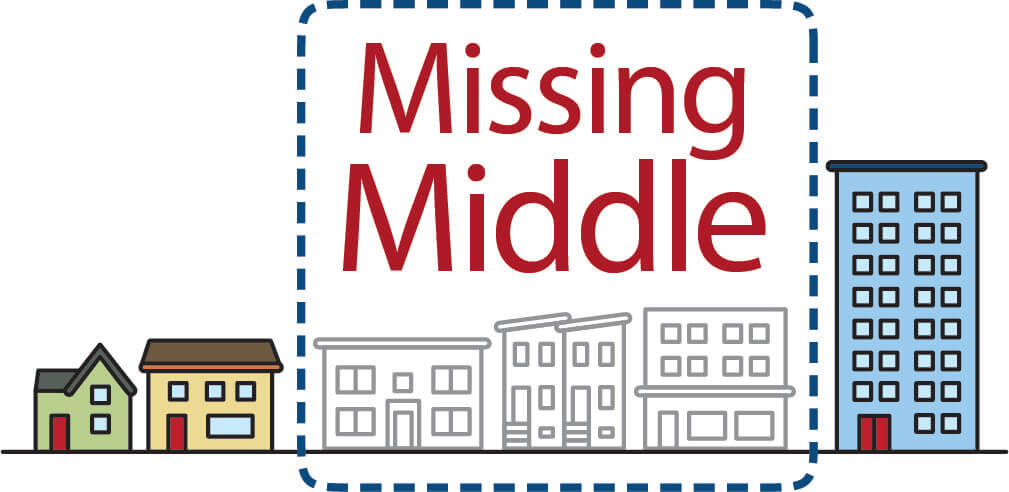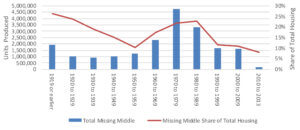What is Missing Middle Housing?
Opticos Design founder Daniel Parolek inspired a new movement for housing choice in 2010 when he coined the term “Missing Middle Housing,” a transformative concept that highlights a time-proven and beloved way to provide more housing and more housing choices in sustainable, walkable places.
Missing Middle Housing:
House-scale buildings
with multiple units
in walkable neighborhoods
These building types, such as duplexes, fourplexes, cottage courts, and courtyard buildings, provide diverse housing options and support locally-serving retail and public transportation options. We call them “Missing” because they have typically been illegal to build since the mid-1940s and “Middle” because they sit in the middle of a spectrum between detached single-family homes and mid-rise to high-rise apartment buildings, in terms of form and scale, as well as number of units and often, affordability. In the diagram below, the Missing Middle types are shown in yellow, providing many housing options in between the single-family homes and higher intensity apartment buildings, both shown in white.

Alliance for Housing Solutions, a housing-advocacy group in Arlington, Virginia, created its own interpretation of the Missing Middle diagram to help communicate the organization’s mission and message effectively. (Source: Alliance for Housing Solutions)
And while they are “missing” from our new building stock, these types of buildings from the 1920s and 30s are beloved by many who have lived in them. Ask around, and your aunt may have fond memories of living in a fourplex as a child, or you might remember visiting your grandmother as she grew old in a duplex with neighbors nearby to help her out. And today, young couples, teachers, single, professional women and baby boomers are among those looking for ways to live in a walkable neighborhood, but without the cost and maintenance burden of a detached single-family home. Missing Middle Housing helps solve the mismatch between the available U.S. housing stock and shifting demographics combined with the growing demand for walkability.
— Debra Bassert, National Association of Home BuildersWe need a greater mix of housing types to meet differing income and generational needs. This is where Missing Middle Housing can change the conversation.”
Opticos Design is driving a radical paradigm shift, urging cities, elected officials, urban planners, architects and builders to fundamentally rethink the way they design, locate, regulate, and develop homes. Americans want and need more diverse housing choices in walkable neighborhoods; homes that are attainable, sustainable, and beautifully designed. The graph below shows Missing Middle units built by decade. It illustrates the steady decline in the number of these units built over the past few decades, which is why they are called “missing” (Source: American Housing Survey, 2013, US Census Bureau).
This website is designed to serve as a collective resource for Missing Middle Housing for elected officials, planners and developers. You will find clear descriptions of housing types best suited for creating walkable neighborhoods, as well as information on the unifying characteristics of these building types. You’ll also find information on how to integrate Missing Middle Housing into existing neighborhoods, how to enable these building types, and pin-point the market demographic that demands them.

— Lynn Richards, President and CEO of the Congress for the New UrbanismIf there’s one thing Americans love, it’s choices: what to eat, where to work, who to vote for. But when it comes where we live or how to get around, our choices can be limited. Many people of all ages would like to live in vibrant neighborhoods, downtowns, and Main Streets—places where jobs and shops lie within walking distance—but right now those places are in short supply. Missing Middle Housing provides more housing choices. And when we have more choices, we create living, thriving neighborhoods for people and businesses.”
